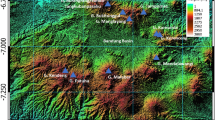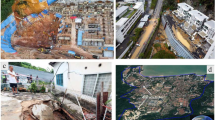Abstract
In the present study, we have introduced a strategic technique for interrelating between slow land surface movement (SLSM) and land susceptibility (LS) map of a higher Himalayan region nearby Gangotri, India by integrating geospatial techniques based on modified frequency ratio technique acquired by optical remote sensing for LS mapping. On the other hand, PS-InSAR technique acquired by microwave remote sensing has been used for monitoring the SLSM. As SLSM is one of the major geological hazard susceptible for highly undulating terrain like Gangotri glacier basin in higher Himalaya which is also a most attractive tourist region in Uttarakhand, India. With the integration of this technology, it would be possible for monitoring SLSM and mapping LS of any hazardous area. PS-InSAR technique allows efficient planning by providing meticulous data about SLSM. PS-InSAR technique is used for monitoring SLSM in scale small within approximately millimetre range. Further, we have used SAR imageries of C band of ENVISAT satellite for the duration of March 2004–May 2007 for nearby Gangotri region. This work also comprises using satellite imageries of Landsat 7, Sentinel 2 and SRTM data for LS mapping purpose. The result shows that in the vicinity of the Gangotri region, the land surface movement was observed around 2 to 18 mm. Also, the study showed that the SLSM affected regions come under the High-risk zone of LS and vice versa.



















Similar content being viewed by others
References
Althuwaynee OF, Pradhan B, Park HJ, Lee JH (2014) A novel ensemble bivariate statistical evidential belief function with knowledge-based analytical hierarchy process and multivariate statistical logistic regression for landslide susceptibility mapping. CATENA 114:21–36. https://doi.org/10.1016/j.catena.2013.10.011
Ayalew L, Yamagishi H (2005) The application of GIS-based logistic regression for landslide susceptibility mapping in the Kakuda–Yahiko Mountains, Central Japan. Geomorphol Sci Direct 65:15–31
Ciampalini A, Raspini F, Lagomarsino D, Catani F, Casagli N (2016) Landslide susceptibility map refinement using PSInSAR data. Remote Sens Environ 184:302–315. https://doi.org/10.1016/j.rse.2016.07.018
Clerici A, Perego S, Tellini C, Vescovi P (2006) A GIS-based automated procedure for landslide susceptibility mapping by the conditional analysis method: the Baganza valley case study (Italian Northern Apennines). Environ Geol 50(7):941–961. https://doi.org/10.1007/s00254-006-0264-7
Ercanoglu M, Gokceoglu C (2002) Assessment of landslide susceptibility for a landslide-prone area (north of Yenice, NW Turkey) by fuzzy approach. Environ Geol 41(6):720–730. https://doi.org/10.1007/s00254-001-0454-2
Ercanoglu M (2005) Landslide susceptibility assessment of SE Bartin (West Black Sea region, Turkey) by artificial neural networks. Nat Hazards Earth Syst Sci 5(6):979–992. https://doi.org/10.5194/nhess-5-979-2005
Greif V, Vlcko J (2013) Application of the PS-InSAR technique for the post-failure landslide deformation monitoring at Lubietova Site in Central Slovakia. In: Margottini C, Canuti P, Sassa K (eds) Landslide science and practice. Springer, Berlin
Hooper A, Zebker H, Segall P, Kampes B (2004) A new method for measuring deformation on volcanoes and other natural terrains using InSAR persistent scatterers. Geophys Res Lett 31(23):1–5. https://doi.org/10.1029/2004GL021737
Holmes A (1945) Principles of physical geology. Ronald Press Co, New York
Kanungo D, Arora M, Sarka S, Gupta R (2006) A comparative study of conventional, ANN black box, fuzzy and combined neural and fuzzy weighting procedures for landslide susceptibility zonation in Darjeeling Himalayas. Eng Geol 85:347–366
Kuri M, Bhattacharya A, Arora MK, Sharma ML (2016) Time series insar techniques to estimate deformation in a landslide-prone area in Haridwar region, India. 2016 IEEE international geoscience and remote sensing symposium (IGARSS), Beijing, pp. 6839–6842. doi: 10.1109/IGARSS.2016.7730785
Lanari R et al (2007) An overview of the small baseline subset algorithm: a DInSAR technique for surface deformation analysis. In: Wolf D, Fernández J (eds) Deformation and gravity change: indicators of isostasy, tectonics, volcanism, and climate change. Pageoph Topical Volumes. Birkhäuser Basel https://doi.org/10.1007/s00024-007-0192-9
Lu L, Liao M (2008) Subsidence measurement with PS-INSAR techniques in Shanghai Urban. International society for photogrammetry and remote sensing (ISPRS) Technical Commission VII Symposium, XXXVII, 173–178
Mallick J, Singh RK, AlAwadh MA, Islam S, Khan RA, Qureshi MN (2018) GIS-based landslide susceptibility evaluation using fuzzy-AHP multi-criteria decision-making techniques in the Abha Watershed, Saudi Arabia. Environ Earth Sci 77(7):1–25. https://doi.org/10.1007/s12665-018-7451-1
Molnar P, Tapponnier P (1978) Active tectonics of Tibet. J Geophys Res 83:5361–5375
Peyret M, Djamour Y, Rizza M, Ritz JF, Hurtrez JE, Goudarzi MA, Nankali H, Chéry J, Le Dortz K, Uri F (2008) Monitoring of the large slow Kahrod landslide in Alborz mountain range (Iran) by GPS and SAR interferometry. Eng Geol 100(3–4):131–141. https://doi.org/10.1016/j.enggeo.2008.02.013
Ram BS, Ramamoorthy M (2016) Landslide susceptibility zonation in Kallar Halla, Upper Coonoor, Lower Coonoor, Upper Katteri and Lower Katteri watershed in part of Nilgiris District, Tami Nadu, India using Remote Sensing and GIL, 3(11), 779–785
Shanker P, Casu F, Zebker HA, Lanari R (2011) Comparison of persistent scatterers and small baseline time-series InSAR results: a case study of the San Francisco Bay area. IEEE Geosci Remote Sens Lett 8(4):592–596. https://doi.org/10.1109/LGRS.2010.2095829
Wager LR (1937) The Arun river drainage pattern and the rise of the Himalaya. Geogr J 89:239–250
Wang C, Shi Y, Zhou W (1982) On the tectonics of the Himalaya and the Tibet Plateau. J. Geophys. Res. 87(B4):2949–2957. https://doi.org/10.1029/JB087iB04p02949
Wu C-H, Chen S-C (2009) Determining landslide susceptibility in Central Taiwan from rainfall and six site factors using the analytical hierarchy process method. Geomorphology 112 (3–4):190–204
Xu C, Xu X, Dai F, Wu Z, He H, Shi F, Wu X, Xu S (2013) Application of an incomplete landslide inventory, logistic regression model and its validation for landslide susceptibility mapping related to the May 12, 2008 Wenchuan earthquake of China. Nat Hazards 68:883–900. https://doi.org/10.1007/s11069-013-0661-7
Author information
Authors and Affiliations
Corresponding author
Additional information
Publisher's Note
Springer Nature remains neutral with regard to jurisdictional claims in published maps and institutional affiliations.
Rights and permissions
About this article
Cite this article
Singh, H., Pandey, A.C. Land deformation monitoring using optical remote sensing and PS-InSAR technique nearby Gangotri glacier in higher Himalayas. Model. Earth Syst. Environ. 7, 221–233 (2021). https://doi.org/10.1007/s40808-020-00889-5
Received:
Accepted:
Published:
Issue Date:
DOI: https://doi.org/10.1007/s40808-020-00889-5




